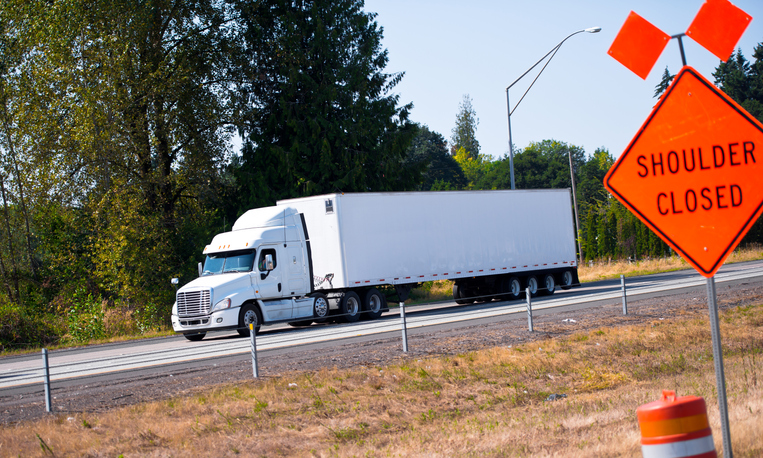To keep the nation’s transportation network functioning in the face of the COVID-19 pandemic, state departments of transportation across the country are engaging in an array of operational efforts, from expanding overweight truck permits and keeping rest areas open to keeping infrastructure projects on track, according to a recent article published in the AASHTO Journal.
To help ensure a steady flow of critical goods as part of the nation’s COVID-19 emergency response, several state DOTs — such as the Missouri Department of Transportation — are putting in place temporary overweight permits so trucking companies can carry heavier loads.
To bolster and broaden the effectiveness of such efforts, the American Association of State Highway and Transportation Officials (AASHTO) wrote a letter to the Federal Highway Administration on March 24, asking the agency to exercise its authority under 23 U.S.C. 127(i) to allow states to issue programmatic — rather than individualized — permits to be applicable on interstate highway system (IHS) routes that can safely handle such temporary increases in axle and gross vehicle weight increases.
“You can be assured that as owners and operators of the IHS, state DOTs will prioritize — as they always do — the safety of the traveling public first and foremost while ensuring preservation of their most critical transportation assets,” AASHTO noted in its letter.
State DOTs are also maintaining ongoing efforts to keep rest areas and parking locations open, sanitized, and available to commercial trucking operators.
The Pennsylvania Department of Transportation reopened indoor facilities at 23 select rest areas across the state to all motorists on March 24, including the 13 facilities in critical locations that were reopened March 18 with portable restrooms and handwashing facilities; these locations were initially closed to help stop the spread of the virus.
In a statement from the Oregon Department of Transportation, Vivian Payne, interim maintenance and operations branch manager said, “We have no plans to close the rest areas as long as we have the staff and cleaning supplies.”
Arizona Department of Transportation crews are providing heightened sanitary protocols, including more frequent cleanings and the regular disinfection of frequently touched surfaces such as door handles, sinks and faucets.
“Rest areas are especially important to commercial drivers, who use truck-parking there to get their required rest,” the Arizona DOT said in a statement.
The agency added that pavement repairs will continue, as will road construction and improvement projects along the nearly 7,000 miles of state highways it is responsible for.
“Around the state, maintenance crews are repairing pavement and guardrails, removing rock fall and performing other work to keep highways operating safely,” the Arizona DOT added. “Construction and improvement projects are moving forward as well, with no anticipated disruptions.”
The Rhode Island Department of Transportation (RIDOT) is also focused on maintain essential services, including road repair, debris removal, sweeping operations and pothole repair, while RIDOT construction teams keep working so active projects remain on time and on budget as much as possible. In addition, the agency’s transportation-management center continues to operate around the clock to provide immediate incident response.
In a similar vein, the West Virginia Department of Transportation (WVDOT) has implemented a plan that allows it to continue conducting essential roadwork and highway emergency response while reducing the number of workers present at one time to reduce risk of exposure to the new coronavirus — all while keeping its rest areas and welcome centers open.
The agency said its transportation workers are now divided into two groups on opposite work schedules. While one group teleworks from home, completing a rigorous training course, the other conducts roadwork and emergency response. At the end of two weeks, the groups will switch.
“There is no way we could maintain our supply chains across the country without the Division of Highways on the ground,” explained Jimmy Wriston, WVDOT deputy secretary in a statement.
“They make sure that (crashes) get cleaned up, guard rails get repaired and issues on the highway are taken care of. To do that, you have to have a good, sound, qualified workforce,” he said. “We’re going to create space, wash our hands, make sure we’re not congregating in places, and take care of the highways by separating our workforce.”
Indeed, an ongoing survey conducted by the American Road & Transportation Builders Association indicates that transportation project shutdowns are “relatively isolated and localized,” except in Pennsylvania, which implemented a statewide halt to transportation activity on March 16. This move was emulated by the Washington State Department of Transportation on March 26, temporarily suspending construction activity for two weeks.
In some cases, the ongoing falloff in highway travel as a result of the pandemic is offering an opportunity to actually speed up roadwork.
“Certainly as we look at the lower traffic counts, particularly in the metropolitan areas, we’re reviewing the ability and the opportunity to possibly do more roadwork during this time because of those lower traffic counts,” explained Jeanny Sharp, communications director for the Kansas Department of Transportation, in a recent interview. The Vermont Agency of Transportation engaged in a similar exercise.
Many state DOTs are also expanding the use of telework options for segments of their workforces to help limit exposure and spread of the new coronavirus, including the Alaska Department of Transportation & Public Facilities and the Ohio Department of Transportation.
“Telework is not going to be possible for every employee, but many of our employees can (work from home),” explained Jack Marchbanks, director of the Ohio DOT, in a video statement. “They can still provide value to the taxpayers of Ohio without increasing the risk of accelerating the spread of this disease.”
The Trucker News Staff produces engaging content for not only TheTrucker.com, but also The Trucker Newspaper, which has been serving the trucking industry for more than 30 years. With a focus on drivers, the Trucker News Staff aims to provide relevant, objective content pertaining to the trucking segment of the transportation industry. The Trucker News Staff is based in Little Rock, Arkansas.








